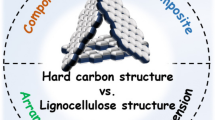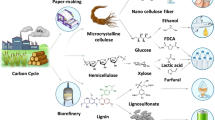Abstract
Cellulose acetate aerogel (CAA) regenerated with toluene solvent was first obtained and analysed in this work using several measurement techniques. CAA, a “green” and environmentally friendly material, with high thermal stability, water absorbency and a porous structure is a hopeful candidate as a superabsorbent and potential heat insulator for various applications. The obtained porous aerogel with a notable surface area (312.5 m2/g) is thermally stable up to about 300 °C and super-absorbent (72.0 g water/1.0 g sample). Thereby, the present study can play an important role in developing production of cellulose acetate based “green” absorbent and potential aerogel materials for heat insulating. Moreover, this process is handily available at low cost, sustainable and favourable for many applications.







Similar content being viewed by others
References
Mahmoud KH (2016) Optical properties of hydroxyethyl cellulose film treated with nitrogen plasma. Spectrochim Acta A 157:153–157
Lee SH, Lee HL, Youn HJ (2014) Adsorption and viscoelastic properties of cationic xylan on cellulose film using QCM-D. Cellulose 21(3):1251–1260
Zhai TL, Zheng QF, Cai ZY, Xia HS, Gong SQ (2016) Synthesis of polyvinyl alcohol/cellulose nanofibril hybrid aerogel microspheres and their use as oil/solvent superabsorbents. Carbohydr Polym 148:300–308
Yang J, Zhang EW, Li XF, Zhang YT, Qu J, Yu ZZ (2016) Cellulose/graphene aerogel supported phase change composites with high thermal conductivity and good shape stability for thermal energy storage. Carbon 98:50–57
Moriana R, Vilaplana F, Ek M (2016) Cellulose nanocrystals from forest residues as reinforcing agents for composites: a study from macro- to nano-dimensions. Carbohydr Polym 139:139–149
Agustin MB, Ahmmad B, Alonzo SMM, Patriana FM (2014) Bioplastic based on starch and cellulose nanocrystals from rice straw. J Reinf Plast Compos 33(24):2205–2213
Tanaka S, Iji M (2012) Novel cellulose-based bioplastic with high durability: cellulose diacetate bonded with cardanol from cashew nutshells and aromatic components. Abstr Pap Am Chem Soc 243:1155
Milovanovic S, Markovic D, Aksentijevic K, Stojanovic DB, Ivanovic J, Zizovic I (2016) Application of cellulose acetate for controlled release of thymol. Carbohydr Polym 147:344–353. https://doi.org/10.1016/j.carbpol.2016.03.093
Israel AU, Obot IB, Umoren SA, Mkpenie V, Asuquo JE (2008) Production of cellulosic polymers from agricultural wastes. E-J Chem 5(1):81–85
Zhang GZ, Huang K, Jiang X, Huang D, Yang YQ (2013) Acetylation of rice straw for thermoplastic applications. Carbohydr Polym 96(1):218–226
Ribeiro K, de Andrade TM, Fujiwara ST (2016) Preparation and application of cellulose acetate/Fe films in the degradation of reactive black 5 dye through photo-fenton reaction. Environ Technol 37(13):1664–1675
Liakos IL, Abdellatif MH, Innocenti C, Scarpellini A, Carzino R, Brunetti V, Marras S, Brescia R, Drago F, Pompa PP (2016) Antimicrobial lemongrass essential oil-copper ferrite cellulose acetate nanocapsules. Molecules 21(4):520
Appaw C, Gilbert RD, Khan SA (2007) Viscoelastic behavior of cellulose acetate in a mixed solvent system. Biomacromolecules 8(5):1541–1547
Son WK, Youk JH, Lee TS, Park WH (2004) Electrospinning of ultrafine cellulose acetate fibers: studies of a new solvent system and deacetylation of ultrafine cellulose acetate fibers. J Polym Sci B 42(1):5–11
Siqueira G, Mathew AP, Oksman K (2011) Processing of cellulose nanowhiskers/cellulose acetate butyrate nanocomposites using sol-gel process to facilitate dispersion. Compos Sci Technol 71(16):1886–1892
Fischer F, Rigacci A, Pirard R, Berthon-Fabry S, Achard P (2006) Cellulose-based aerogels. Polymer 47(22):7636–7645
Pierre AC, Pajonk GM (2002) Chemistry of aerogels and their applications. Chem Rev 102(11):4243–4265
Kaya M (2016) Synthesis and characterization of cellulose based bio-polymer aerogel isolated from waste of blueberry tree (Vaccinium myrtillus). J Turk Chem Soc A 3(3):765–776
Kaya M (2017) Super absorbent, light, and highly flame retardant cellulose-based aerogel crosslinked with citric acid. J Appl Polym Sci 134:45315–45323
Baetens R, Jelle BP, Gustavsen A (2011) Aerogel insulation for building applications: a state-of-the-art review. Energy Build 43(4):761–769
Jones SM (2006) Aerogel: space exploration applications. J Sol-Gel Sci Technol 40(2–3):351–357
Liu NP, Shen J, Liu D (2013) Activated high specific surface area carbon aerogels for EDLCs. Microporous Mesoporous Mater 167:176–181
Shin EJ, Choi SM, Singh D, Zo SM, Lee YH, Kim JH, Han SS (2014) Fabrication of cellulose-based scaffold with microarchitecture using a leaching technique for biomedical applications. Cellulose 21(5):3515–3525. https://doi.org/10.1007/s10570-014-0368-2
Cai J, Kimura S, Wada M, Kuga S, Zhang L (2008) Cellulose aerogels from aqueous alkali hydroxide-urea solution. Chemsuschem 1(1–2):149–154
Chen WS, Yu HP, Li Q, Liu YX, Li J (2011) Ultralight and highly flexible aerogels with long cellulose I nanofibers. Soft Matter 7(21):10360–10368
Heath L, Thielemans W (2010) Cellulose nanowhisker aerogels. Green Chem 12(8):1448–1453. https://doi.org/10.1039/C0GC00035C
Han YY, Zhang XX, Wu XD, Lu CH (2015) Flame retardant, heat insulating cellulose aerogels from waste cotton fabrics by in situ formation of magnesium hydroxide nanoparticles in cellulose gel nanostructures. ACS Sustain Chem Eng 3(8):1853–1859
Kamal H, Abd-Elrahim FM, Lotfy S (2014) Characterization and some properties of cellulose acetate-co-polyethylene oxide blends prepared by the use of gamma irradiation. J Radiat Res Appl Sci 7(2):146–153. https://doi.org/10.1016/j.jrras.2014.01.003
Song JL, Birbach NL, Hinestroza JP (2012) Deposition of silver nanoparticles on cellulosic fibers via stabilization of carboxymethyl groups. Cellulose 19(2):411–424
Zavastin D, Cretescu I, Bezdadea M, Bourceanu M, Drăgan M, Lisa G, Mangalagiu I, Vasić V, Savić J (2010) Preparation, characterization and applicability of cellulose acetate–polyurethane blend membrane in separation techniques. Colloids Surf A 370(1):120–128. https://doi.org/10.1016/j.colsurfa.2010.08.058
John A, Chen Y, Kim J (2012) Synthesis and characterization of cellulose acetate–calcium carbonate hybrid nanocomposite. Composites B 43(2):522–525. https://doi.org/10.1016/j.compositesb.2011.08.021
Proniewicz LM, Paluszkiewicz C, Wesełucha-Birczyńska A, Majcherczyk H, Barański A, Konieczna A (2001) FT-IR and FT-Raman study of hydrothermally degradated cellulose. J Mol Struct 596(1):163–169. https://doi.org/10.1016/S0022-2860(01)00706-2
Kim D-Y, Nishiyama Y, Kuga S (2002) Surface acetylation of bacterial cellulose. Cellulose 9(3):361–367. https://doi.org/10.1023/a:1021140726936
Anitha S, Brabu B, Thiruvadigal DJ, Gopalakrishnan C, Natarajan TS (2012) Optical, bactericidal and water repellent properties of electrospun nano-composite membranes of cellulose acetate and ZnO. Carbohydr Polym 87(2):1065–1072. https://doi.org/10.1016/j.carbpol.2011.08.030
Rouquerol J, Avnir D, Fairbridge CW, Everett DH, Haynes JH, Pernicone N, Ramsay JDF, Sing KSW, Unger KK (1994) Recommendations for the characterization of porous solids. Pure Appl Chem 66(8):1739–1758
Branton PJ, Hall PG, Sing KSW, Reichert H, Schuth F, Unger KK (1994) Physisorption of argon, nitrogen and oxygen by Mcm-41, a model mesoporous adsorbent. J Chem Soc Faraday T 90(19):2965–2967
Brunauer S, Emmett PH, Teller E (1938) Adsorption of gases in multimolecular layers. J Am Chem Soc 60(2):309–319. https://doi.org/10.1021/ja01269a023
Sehaqui H, Zhou Q, Berglund LA (2011) High-porosity aerogels of high specific surface area prepared from nanofibrillated cellulose (NFC). Compos Sci Technol 71(13):1593–1599. https://doi.org/10.1016/j.compscitech.2011.07.003
Lucena MDC, de Alencar AEV, Mazzeto SE, Soares SD (2003) The effect of additives on the thermal degradation of cellulose acetate. Polym Degrad Stabil 80(1):149–155
Jiang F, Hsieh YL (2017) Cellulose nanofibril aerogels: synergistic improvement of hydrophobicity, strength, and thermal stability via cross-linking with diisocyanate. ACS Appl Mater Interfaces 9(3):2825–2834
Sehaqui H, Salajkova M, Zhou Q, Berglund LA (2010) Mechanical performance tailoring of tough ultra-high porosity foams prepared from cellulose I nanofiber suspensions. Soft Matter 6(8):1824–1832
Zhang W, Zhang Y, Lu CH, Deng YL (2012) Aerogels from crosslinked cellulose nano/micro-fibrils and their fast shape recovery property in water. J Mater Chem 22(23):11642–11650
Nguyen ST, Feng JD, Ng SK, Wong JPW, Tan VBC, Duong HM (2014) Advanced thermal insulation and absorption properties of recycled cellulose aerogels. Colloid Surf A 445:128–134
Acknowledgements
The authors thank the Research Fund of Recep Tayyip Erdoğan University, Department of Chemistry for the financial support of this work.
Author information
Authors and Affiliations
Corresponding author
Ethics declarations
Conflict of interest
The authors declare that there is no conflict of interest regarding the publication of this paper.
Additional information
Publisher's Note
Springer Nature remains neutral with regard to jurisdictional claims in published maps and institutional affiliations.
Rights and permissions
About this article
Cite this article
Kaya, M., Demir, A. & Akçay, H.T. A Novel Highly Porous Cellulosic Aerogel Regenerated by Solvent Exchange Mechanism. J Polym Environ 27, 1801–1806 (2019). https://doi.org/10.1007/s10924-019-01476-1
Published:
Issue Date:
DOI: https://doi.org/10.1007/s10924-019-01476-1




